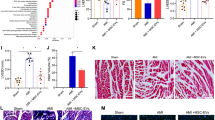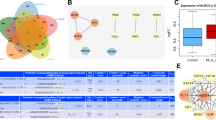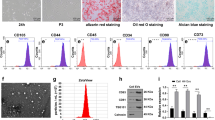Abstract
Extracellular vesicles (EVs) derived from mouse bone marrow mesenchymal stem cells (mBMSCs) convey the CAV1 protein, influencing the TGF-β1/SMAD2/c-JUN pathway and thus the molecular mechanisms underlying myocardial fibrosis (MF) post-myocardial infarction (MI). Through various experimental methods, including transmission electron microscopy, Nanosight analysis, Western blot, ELISA, and qRT-PCR, we isolated, purified, and identified EVs originating from mBMSCs. Bioinformatics and experimental findings show a reduced expression of CAV1 in myocardial fibrosis tissue. Furthermore, our findings suggest that mBMSC-EVs can deliver CAV1 to cardiac fibroblasts (CFs) and that silencing CAV1 in mBMSC-EVs promotes CF fibrosis. In vivo studies further corroborated these findings. In conclusion, mBMSC-EVs mitigate myocardial fibrosis in MI mice by delivering the CAV1 protein, inhibiting the TGF-β1/SMAD2/c-JUN pathway.
Graphical Abstract

Molecular mechanism of mBMSC-EVs-CAV1-mediated TGF-β1/SMAD2/c-JUN axis in inhibiting cardiac fibroblast differentiation to improve MF after MI. mBMSC-EVs deliver CAV1 protein to CFs where the protein expression of CAV1 is upregulated upon hypoxia conditions. The TGF-β1/SMAD2 signaling pathway downstream of CAV1 is consequently inactivated, the transcription of c-JUN is inhibited, and transcription of SMAD2/c-JUN transcription complex target genes α-SMA and Collagen I is reduced. By this mechanism, CF fibrosis and apoptosis are suppressed in vitro and MF is ameliorated in MI mice.








Similar content being viewed by others
Data Availability
The datasets generated and analyzed during the current study are available from the corresponding author upon reasonable request.
References
Chiang MH, Liang CJ, Lin LC, Yang YF, Huang CC, Chen YH, et al. miR-26a attenuates cardiac apoptosis and fibrosis by targeting ataxia-telangiectasia mutated in myocardial infarction. J Cell Physiol. 2020;235:6085–102. https://doi.org/10.1002/jcp.29537.
Zhao Z, Du S, Shen S, Wang L. microRNA-132 inhibits cardiomyocyte apoptosis and myocardial remodeling in myocardial infarction by targeting IL-1beta. J Cell Physiol. 2020;235:2710–21. https://doi.org/10.1002/jcp.29175.
Golforoush P, Yellon DM, Davidson SM. Mouse models of atherosclerosis and their suitability for the study of myocardial infarction. Basic Res Cardiol. 2020;115:73. https://doi.org/10.1007/s00395-020-00829-5.
Daseke MJ 2nd, Tenkorang MAA, Chalise U, Konfrst SR, Lindsey ML. Cardiac fibroblast activation during myocardial infarction wound healing: fibroblast polarization after MI. Matrix Biol. 2020;91-92:109–16. https://doi.org/10.1016/j.matbio.2020.03.010.
Kurose H. Cardiac Fibrosis and Fibroblasts. Cells. 2021;10 https://doi.org/10.3390/cells10071716.
Prabhu SD, Frangogiannis NG. The biological basis for cardiac repair after myocardial infarction: from inflammation to fibrosis. Circ Res. 2016;119:91–112. https://doi.org/10.1161/CIRCRESAHA.116.303577.
Miao C, Lei M, Hu W, Han S, Wang Q. A brief review: the therapeutic potential of bone marrow mesenchymal stem cells in myocardial infarction. Stem Cell Res Ther. 2017;8:242. https://doi.org/10.1186/s13287-017-0697-9.
Woith E, Fuhrmann G, Melzig MF. Extracellular vesicles-connecting kingdoms. Int J Mol Sci. 2019;20 https://doi.org/10.3390/ijms20225695.
Bian S, Zhang L, Duan L, Wang X, Min Y, Yu H. Extracellular vesicles derived from human bone marrow mesenchymal stem cells promote angiogenesis in a rat myocardial infarction model. J Mol Med (Berl). 2014;92:387–97. https://doi.org/10.1007/s00109-013-1110-5.
Keshtkar S, Azarpira N, Ghahremani MH. Mesenchymal stem cell-derived extracellular vesicles: novel frontiers in regenerative medicine. Stem Cell Res Ther. 2018;9:63. https://doi.org/10.1186/s13287-018-0791-7.
Lin CJ, Yun EJ, Lo UG, Tai YL, Deng S, Hernandez E, et al. The paracrine induction of prostate cancer progression by caveolin-1. Cell Death Dis. 2019;10:834. https://doi.org/10.1038/s41419-019-2066-3.
Gvaramia D, Blaauboer ME, Hanemaaijer R, Everts V. Role of caveolin-1 in fibrotic diseases. Matrix Biol. 2013;32:307–15. https://doi.org/10.1016/j.matbio.2013.03.005.
Shivshankar P, Halade GV, Calhoun C, Escobar GP, Mehr AJ, Jimenez F, et al. Caveolin-1 deletion exacerbates cardiac interstitial fibrosis by promoting M2 macrophage activation in mice after myocardial infarction. J Mol Cell Cardiol. 2014;76:84–93. https://doi.org/10.1016/j.yjmcc.2014.07.020.
Lu J, Zhang J, Wang Y, Sun Q. Caveolin-1 scaffolding domain peptides alleviate liver fibrosis by inhibiting TGF-beta1/Smad signaling in mice. Int J Mol Sci. 2018;19 https://doi.org/10.3390/ijms19061729.
Lu M, Qin Q, Yao J, Sun L, Qin X. Induction of LOX by TGF-beta1/Smad/AP-1 signaling aggravates rat myocardial fibrosis and heart failure. IUBMB Life. 2019;71:1729–39. https://doi.org/10.1002/iub.2112.
Qiu H, Liu W, Lan T, Pan W, Chen X, Wu H, et al. Salvianolate reduces atrial fibrillation through suppressing atrial interstitial fibrosis by inhibiting TGF-beta1/Smad2/3 and TXNIP/NLRP3 inflammasome signaling pathways in post-MI rats. Phytomedicine. 2018;51:255–65. https://doi.org/10.1016/j.phymed.2018.09.238.
Barrett T, Wilhite SE, Ledoux P, Evangelista C, Kim IF, Tomashevsky M, et al. NCBI GEO: archive for functional genomics data sets--update. Nucleic Acids Res. 2013;41:D991–5. https://doi.org/10.1093/nar/gks1193.
Keerthikumar S, Chisanga D, Ariyaratne D, Al Saffar H, Anand S, Zhao K, et al. ExoCarta: a web-based compendium of exosomal cargo. J Mol Biol. 2016;428:688–92. https://doi.org/10.1016/j.jmb.2015.09.019.
Yang H, Robinson PN, Wang K. Phenolyzer: phenotype-based prioritization of candidate genes for human diseases. Nat Methods. 2015;12:841–3. https://doi.org/10.1038/nmeth.3484.
Szklarczyk D, Gable AL, Lyon D, Junge A, Wyder S, Huerta-Cepas J, et al. STRING v11: protein-protein association networks with increased coverage, supporting functional discovery in genome-wide experimental datasets. Nucleic Acids Res. 2019;47:D607–D13. https://doi.org/10.1093/nar/gky1131.
Shannon P, Markiel A, Ozier O, Baliga NS, Wang JT, Ramage D, et al. Cytoscape: a software environment for integrated models of biomolecular interaction networks. Genome Res. 2003;13:2498–504. https://doi.org/10.1101/gr.1239303.
Zhou G, Soufan O, Ewald J, Hancock REW, Basu N, Xia J. NetworkAnalyst 3.0: a visual analytics platform for comprehensive gene expression profiling and meta-analysis. Nucleic Acids Res. 2019;47:W234–W41. https://doi.org/10.1093/nar/gkz240.
Chen B, Luo L, Wei X, Gong D, Li Z, Li S, et al. M1 Bone marrow-derived macrophage-derived extracellular vesicles inhibit angiogenesis and myocardial regeneration following myocardial infarction via the MALAT1/MicroRNA-25-3p/CDC42 Axis. Oxid Med Cell Longev. 2021;2021:9959746. https://doi.org/10.1155/2021/9959746.
Zhu LP, Tian T, Wang JY, He JN, Chen T, Pan M, et al. Hypoxia-elicited mesenchymal stem cell-derived exosomes facilitates cardiac repair through miR-125b-mediated prevention of cell death in myocardial infarction. Theranostics. 2018;8:6163–77. https://doi.org/10.7150/thno.28021.
Wu Y, Peng W, Fang M, Wu M, Wu M. MSCs-derived extracellular vesicles carrying miR-212-5p alleviate myocardial infarction-induced cardiac fibrosis via NLRC5/VEGF/TGF-beta1/SMAD Axis. J Cardiovasc Transl Res. 2022;15:302–16. https://doi.org/10.1007/s12265-021-10156-2.
Gao W, Shao R, Zhang X, Liu D, Liu Y, Fa X. Up-regulation of caveolin-1 by DJ-1 attenuates rat pulmonary arterial hypertension by inhibiting TGFbeta/Smad signaling pathway. Exp Cell Res. 2017;361:192–8. https://doi.org/10.1016/j.yexcr.2017.10.019.
Han M, Gu Y, Lu P, Li J, Cao H, Li X, et al. Exosome-mediated lncRNA AFAP1-AS1 promotes trastuzumab resistance through binding with AUF1 and activating ERBB2 translation. Mol Cancer. 2020;19:26. https://doi.org/10.1186/s12943-020-1145-5.
Hinkelbein J, Bohm L, Braunecker S, Adler C, De Robertis E, Cirillo F. Decreased tissue COX5B expression and mitochondrial dysfunction during sepsis-induced kidney injury in rats. Oxid Med Cell Longev. 2017;2017:8498510. https://doi.org/10.1155/2017/8498510.
Yu SY, Dong B, Fang ZF, Hu XQ, Tang L, Zhou SH. Knockdown of lncRNA AK139328 alleviates myocardial ischaemia/reperfusion injury in diabetic mice via modulating miR-204-3p and inhibiting autophagy. J Cell Mol Med. 2018;22:4886–98. https://doi.org/10.1111/jcmm.13754.
Borger V, Bremer M, Ferrer-Tur R, Gockeln L, Stambouli O, Becic A, et al. Mesenchymal stem/stromal cell-derived extracellular vesicles and their potential as novel immunomodulatory therapeutic agents. Int J Mol Sci. 2017;18 https://doi.org/10.3390/ijms18071450.
Han C, Zhou J, Liang C, Liu B, Pan X, Zhang Y, et al. Human umbilical cord mesenchymal stem cell derived exosomes encapsulated in functional peptide hydrogels promote cardiac repair. Biomater Sci. 2019;7:2920–33. https://doi.org/10.1039/c9bm00101h.
Zhao Y, Sun X, Cao W, Ma J, Sun L, Qian H, et al. Exosomes derived from human umbilical cord mesenchymal stem cells relieve acute myocardial ischemic injury. Stem Cells Int. 2015;2015:761643. https://doi.org/10.1155/2015/761643.
Sundqvist A, Vasilaki E, Voytyuk O, Bai Y, Morikawa M, Moustakas A, et al. TGFbeta and EGF signaling orchestrates the AP-1- and p63 transcriptional regulation of breast cancer invasiveness. Oncogene. 2020;39:4436–49. https://doi.org/10.1038/s41388-020-1299-z.
Sposito AC, de Lima-Junior JC, Moura FA, Barreto J, Bonilha I, Santana M, et al. Reciprocal multifaceted interaction between HDL (high-density lipoprotein) and myocardial infarction. Arterioscler Thromb Vasc Biol. 2019;39:1550–64. https://doi.org/10.1161/ATVBAHA.119.312880.
Wang N, Chen C, Yang D, Liao Q, Luo H, Wang X, et al. Mesenchymal stem cells-derived extracellular vesicles, via miR-210, improve infarcted cardiac function by promotion of angiogenesis. Biochim Biophys Acta Mol Basis Dis. 2017;1863:2085–92. https://doi.org/10.1016/j.bbadis.2017.02.023.
Riaud M, Martinez MC, Montero-Menei CN. Scaffolds and extracellular vesicles as a promising approach for cardiac regeneration after myocardial infarction. Pharmaceutics. 2020;12 https://doi.org/10.3390/pharmaceutics12121195.
Viola M, de Jager SCA, Sluijter JPG. Targeting inflammation after myocardial infarction: a therapeutic opportunity for extracellular vesicles? Int J Mol Sci. 2021;22 https://doi.org/10.3390/ijms22157831.
van Niel G, D'Angelo G, Raposo G. Shedding light on the cell biology of extracellular vesicles. Nat Rev Mol Cell Biol. 2018;19:213–28. https://doi.org/10.1038/nrm.2017.125.
Silva AM, Lazaro-Ibanez E, Gunnarsson A, Dhande A, Daaboul G, Peacock B, et al. Quantification of protein cargo loading into engineered extracellular vesicles at single-vesicle and single-molecule resolution. J Extracell Vesicles. 2021;10:e12130. https://doi.org/10.1002/jev2.12130.
Cohen AW, Park DS, Woodman SE, Williams TM, Chandra M, Shirani J, et al. Caveolin-1 null mice develop cardiac hypertrophy with hyperactivation of p42/44 MAP kinase in cardiac fibroblasts. Am J Physiol Cell Physiol. 2003;284:C457–74. https://doi.org/10.1152/ajpcell.00380.2002.
Quintas LE, Pierre SV, Liu L, Bai Y, Liu X, Xie ZJ. Alterations of Na+/K+-ATPase function in caveolin-1 knockout cardiac fibroblasts. J Mol Cell Cardiol. 2010;49:525–31. https://doi.org/10.1016/j.yjmcc.2010.04.015.
Zhu JZ, Bao XY, Zheng Q, Tong Q, Zhu PC, Zhuang Z, et al. Buyang Huanwu decoction exerts cardioprotective effects through targeting angiogenesis via caveolin-1/VEGF signaling pathway in mice with acute myocardial infarction. Oxid Med Cell Longev. 2019;2019:4275984. https://doi.org/10.1155/2019/4275984.
Bai L, Li A, Gong C, Ning X, Wang Z. Protective effect of rutin against bleomycin induced lung fibrosis: involvement of TGF-beta1/alpha-SMA/Col I and III pathway. Biofactors. 2020;46:637–44. https://doi.org/10.1002/biof.1629.
Kandhare AD, Bodhankar SL, Mohan V, Thakurdesai PA. Effect of glycosides based standardized fenugreek seed extract in bleomycin-induced pulmonary fibrosis in rats: decisive role of Bax, Nrf2, NF-kappaB, Muc5ac, TNF-alpha and IL-1beta. Chem Biol Interact. 2015;237:151–65. https://doi.org/10.1016/j.cbi.2015.06.019.
Radhiga T, Senthil S, Sundaresan A, Pugalendi KV. Ursolic acid modulates MMPs, collagen-I, alpha-SMA, and TGF-beta expression in isoproterenol-induced myocardial infarction in rats. Hum Exp Toxicol. 2019;38:785–93. https://doi.org/10.1177/0960327119842620.
Emran T, Chowdhury NI, Sarker M, Bepari AK, Hossain M, Rahman GMS, et al. L-carnitine protects cardiac damage by reducing oxidative stress and inflammatory response via inhibition of tumor necrosis factor-alpha and interleukin-1beta against isoproterenol-induced myocardial infarction. Biomed Pharmacother. 2021;143:112139. https://doi.org/10.1016/j.biopha.2021.112139.
Zhang Z, Yang C, Shen M, Yang M, Jin Z, Ding L, et al. Autophagy mediates the beneficial effect of hypoxic preconditioning on bone marrow mesenchymal stem cells for the therapy of myocardial infarction. Stem Cell Res Ther. 2017;8:89. https://doi.org/10.1186/s13287-017-0543-0.
Firoozi S, Pahlavan S, Ghanian MH, Rabbani S, Barekat M, Nazari A, et al. Mesenchymal stem cell-derived extracellular vesicles alone or in conjunction with a SDKP-conjugated self-assembling peptide improve a rat model of myocardial infarction. Biochem Biophys Res Commun. 2020;524:903–9. https://doi.org/10.1016/j.bbrc.2020.02.009.
Ning H, Chen H, Deng J, Xiao C, Xu M, Shan L, et al. Exosomes secreted by FNDC5-BMMSCs protect myocardial infarction by anti-inflammation and macrophage polarization via NF-kappaB signaling pathway and Nrf2/HO-1 axis. Stem Cell Res Ther. 2021;12:519. https://doi.org/10.1186/s13287-021-02591-4.
Jasmin JF, Rengo G, Lymperopoulos A, Gupta R, Eaton GJ, Quann K, et al. Caveolin-1 deficiency exacerbates cardiac dysfunction and reduces survival in mice with myocardial infarction. Am J Physiol Heart Circ Physiol. 2011;300:H1274–81. https://doi.org/10.1152/ajpheart.01173.2010.
Gao Y, Chu M, Hong J, Shang J, Xu D. Hypoxia induces cardiac fibroblast proliferation and phenotypic switch: a role for caveolae and caveolin-1/PTEN mediated pathway. J Thorac Dis. 2014;6:1458–68. https://doi.org/10.3978/j.issn.2072-1439.2014.08.31.
Zhao S, Li W, Yu W, Rao T, Li H, Ruan Y, et al. Exosomal miR-21 from tubular cells contributes to renal fibrosis by activating fibroblasts via targeting PTEN in obstructed kidneys. Theranostics. 2021;11:8660–73. https://doi.org/10.7150/thno.62820.
Samaeekia R, Rabiee B, Putra I, Shen X, Park YJ, Hematti P, et al. Effect of human corneal mesenchymal stromal cell-derived exosomes on corneal epithelial wound healing. Invest Ophthalmol Vis Sci. 2018;59:5194–200. https://doi.org/10.1167/iovs.18-24803.
Huang K, Garimella S, Clay-Gilmour A, Vojtech L, Armstrong B, Bessonny M, et al. Comparison of human urinary exosomes isolated via ultracentrifugation alone versus ultracentrifugation followed by SEC column-purification. J Pers Med. 2022;12 https://doi.org/10.3390/jpm12030340.
Thery C, Witwer KW, Aikawa E, Alcaraz MJ, Anderson JD, Andriantsitohaina R, et al. Minimal information for studies of extracellular vesicles 2018 (MISEV2018): a position statement of the International Society for Extracellular Vesicles and update of the MISEV2014 guidelines. J Extracell Vesicles. 2018;7:1535750. https://doi.org/10.1080/20013078.2018.1535750.
Zhang M, Wang H, Bie M, Wang X, Lu K, Xiao H. Caveolin-1 deficiency induces atrial fibrosis and increases susceptibility to atrial fibrillation by the STAT3 signaling pathway. J Cardiovasc Pharmacol. 2021;78:175–83. https://doi.org/10.1097/FJC.0000000000001066.
Zhang M, Wang H, Wang X, Bie M, Lu K, Xiao H. MG53/CAV1 regulates transforming growth factor-beta1 signaling-induced atrial fibrosis in atrial fibrillation. Cell Cycle. 2020;19:2734–44. https://doi.org/10.1080/15384101.2020.1827183.
Tu JH, Xu Y, Dai Y, Dang L. Effect of alprostadil on myocardial fibrosis in rats with diabetes mellitus via TGF-beta1/Smad signaling pathway. Eur Rev Med Pharmacol Sci. 2019;23:9633–41. https://doi.org/10.26355/eurrev_201911_19457.
Chen Y, Li T, Gao Q, Wang LY, Cui LQ. MiR-1908 improves cardiac fibrosis after myocardial infarction by targeting TGF-beta1. Eur Rev Med Pharmacol Sci. 2018;22:2061–9. https://doi.org/10.26355/eurrev_201804_14736.
Shen Z, Shen A, Chen X, Wu X, Chu J, Cheng Y, et al. Huoxin pill attenuates myocardial infarction-induced apoptosis and fibrosis via suppression of p53 and TGF-beta1/Smad2/3 pathways. Biomed Pharmacother. 2020;130:110618. https://doi.org/10.1016/j.biopha.2020.110618.
Wang J, Ma Y, Sachs F, Li J, Suchyna TM. GsMTx4-D is a cardioprotectant against myocardial infarction during ischemia and reperfusion. J Mol Cell Cardiol. 2016;98:83–94. https://doi.org/10.1016/j.yjmcc.2016.07.005.
Szostek-Mioduchowska AZ, Lukasik K, Skarzynski DJ, Okuda K. Effect of transforming growth factor -beta1 on alpha-smooth muscle actin and collagen expression in equine endometrial fibroblasts. Theriogenology. 2019;124:9–17. https://doi.org/10.1016/j.theriogenology.2018.10.005.
Zhou JP, Tang W, Feng Y, Li N, Gu CJ, Li QY, et al. Angiotensin-(1-7) decreases the expression of collagen I via TGF-beta1/Smad2/3 and subsequently inhibits fibroblast-myofibroblast transition. Clin Sci (Lond). 2016;130:1983–91. https://doi.org/10.1042/CS20160193.
Funding
This study was supported by the Basic and Applied Basic Research Project of Guangzhou Basic Research Plan (202201011721).
Author information
Authors and Affiliations
Corresponding author
Ethics declarations
Ethics Statement
Animal experimentations were authorized by the Animal Ethics Committee of Guangdong Provincial People's Hospital (Guangdong Academy of Medical Sciences; Guangdong Cardiovascular Institute) (No. KY-7.-2022-2317-01). Appropriate measures had been taken to avoid any unnecessary distress to the animals. This study was approved by the Ethics Committee of Guangdong Provincial People’s Hospital (Guangdong Academy of Medical Sciences; Guangdong Cardiovascular Institute), and the methods were carried out following the approved guidelines. All the patients have been informed and signed informed consent before the experiments.
Consent for Publication
Not applicable.
Competing Interests
The authors declare no competing interests.
Additional information
Associate Editor Nicola Smart oversaw the review of this article
Publisher’s Note
Springer Nature remains neutral with regard to jurisdictional claims in published maps and institutional affiliations.
Yijin Wu and Wenying Peng are regarded as co-first authors.
Rights and permissions
Springer Nature or its licensor (e.g. a society or other partner) holds exclusive rights to this article under a publishing agreement with the author(s) or other rightsholder(s); author self-archiving of the accepted manuscript version of this article is solely governed by the terms of such publishing agreement and applicable law.
About this article
Cite this article
Wu, Y., Peng, W., Chen, S. et al. CAV1 Protein Encapsulated in Mouse BMSC-Derived Extracellular Vesicles Alleviates Myocardial Fibrosis Following Myocardial Infarction by Blocking the TGF-β1/SMAD2/c-JUN Axis. J. of Cardiovasc. Trans. Res. (2023). https://doi.org/10.1007/s12265-023-10472-9
Received:
Accepted:
Published:
DOI: https://doi.org/10.1007/s12265-023-10472-9







